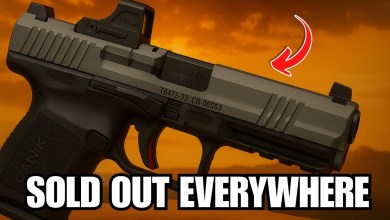Yokohama Geolandar A/T4 Review: A Solid Step Forward Into Legit All-Terrain Capability

Stiff competition in today’s off-road tire industry means that every manufacturer needs to continuously improve, or get left — quite literally — in the dust. The new Yokohama Geolandar G018 A/T4 tire is no different, aiming to improve on the long-tenured Geolandar G015. The recipe is simple: more rugged looks and more off-road capability, without sacrificing road manners or durability.
I tested the new A/T4 last summer on a Ford Bronco Sasquatch, and then replaced a set of the existing G015 on my 1997 Mitsubishi Pajero Evolution. Now, just over 3,000 miles later, I am impressed with the forward strides of Yokohama’s latest and greatest. However, I have some hesitations about pricing and proficiency versus other options in the all-terrain segment.
With the Yokohama Geolandar G018 A/T, the brand is looking to keep up in the ever-escalating all-terrain tire arms race. It is more rugged both in looks and in capability than the model it replaces. But as we learn with some time with this new option, it’s not perfect.
In short: Yokohama desperately needed a new tire to keep up in the arms race against BFGoodrich, Toyo, and Falken. The new Geolandar G018 A/T4 definitely looks better, and it rides with noticeably more refined compliance and traction. But the improvements come at the cost of more road noise, and after 3,000 hard miles, my tires do show some slight signs of wear.
-
Rugged looks take a step forward -
More aggressive tread and shoulder design -
3-Peak Mountain Snowflake rated
-
More tire hum from road and wind -
Priced slightly higher than expected, depending on size
Yokohama Geolandar G018 A/T4 Review
The Geolandar G018 A/T4 replaces the G015, which was definitely outgunned versus the competition in almost every way.
I lived with a set of the outgoing tires for about 5,000 miles, pushing hard to explore the limits of my JDM homologation special as much as the tires. After nearly 2 years, I traded up to the A/T4 after being just moderately impressed by how the G015 rode.
The old tires were quiet, but more similar to a true LT tire than a typical all-terrain. The rectangular profile, without much shoulder grip and thin spacing of tread blocks, looked more like a Marine’s high and tight haircut. I especially compared them against the Toyo Open Country A/T III tires on my mildly built 2006 Porsche Cayenne Turbo, and the G015s definitely played second fiddle.
The New Geolandar Visits Texas
I sold the Cayenne in late 2023, but I plan to keep my PajEvo for life. Whether the old Geolandars would last that long looked like a serious question, but then Yokohama invited me out for first impressions of the A/T4 at a launch event held in Texas last summer. In a Ford Bronco Sasquatch, I pushed the new tires through scraggly rocks and rutted wagon trails — plus a surprising amount of water fording and some mud.
Yoko reps aired our LT315/70R17 tires down to 20 psi, but the trip ended up teaching me more about the Bronco than the rubber. I had only driven a Bronco Raptor previously, and it’s hard to make judgments while off-roading an entirely new 4×4. The A/T4 tires got the job done well enough, though, that when Yokohama offered me a set for long-term testing, I didn’t hesitate to accept.
More About the Rally Homologation Test Rig
I definitely wanted to move on from the G015s, but availability from other tire manufacturers came into play. Most companies don’t prioritize tires for 16-inch wheels like the Pajero Evolutions. And in fairness, the PajEvo itself is also something of an unusual testbed.
It’s a legitimate homologation special, with a short wheelbase and independent rear suspension. This makes it lightweight for an SUV, but also moderately powerful — it might have been the quickest SUV in the world in 1997.
Today, I love off-roading in the PajEvo, but it’s such a good all-rounder that I also drive it daily in Los Angeles when I don’t have press loaners. And without exaggeration, the suspension is so good that I can legitimately keep up with most sports cars in the canyons. That’s despite the age, tire sidewall, and upright posture — rally cars, baby!
I originally connected with Yokohama, hoping to learn more about that rally heritage. That was after I had met some engineers from Japan at a Nitro Rallycross event, and asked about the original Dakar Rally races.
I had seen a few historical pics of PajEvos in Africa wearing Yokohama tires, but the engineers explained that the factory teams would have run BFG/Michelin rubber. Old pics with Yokos would have therefore been privateer efforts.
Yokohamas Just Look Right on a JDM Import
Still, it seemed appropriate to mount Geolandars on my PajEvo once I imported it, because most of the homologation cars sold new for the Japanese domestic market (JDM) ride on Geolandar HTs. So I happily took a set of G015s in the LT265/75R16 size, or 1 inch taller than the factory spec. This emphasized the tall, skinny aesthetic that looks so good on old SUVs.
After nearly 2 years with the G015, I was excited to swap out for the G018 A/T4 for a few reasons. Yokohama’s press materials advertise multiple sidewall plies, triple polymer construction, and a thick center tread with wide shoulder blocks.
My time in Texas had proven quickly that the new tires definitely took a more aggressive tack than the older ones. But even just mounting the A/T4s, I immediately noticed a different personality, with more of a rounded sidewall and a bolder look overall to suit the PajEvo’s cartoonish character. Meanwhile, I gave the old G015s to a friend with a Tacoma and told him to keep track of his mileage and wear for me.
Yokohama Geolandar G018 Pushed on the Pavement
As soon as I pulled out onto the highway from the tire shop, I could sense Yokohama’s hard work on the A/T4. In Texas, we’d only ridden off-road or around a ranch. But even pulling out of the driveway, the new tire’s compliance showed immediately. I run the PajEvo’s tires at 38 psi, which is definitely low for an LT tire, but the 4,300-pound SUV’s modest weight means I don’t need to stick with serious pressures.
I then accelerated up to freeway speeds and noticed more tire hum immediately. That’s usually a tradeoff with a more aggressive design, and I wondered whether I should pump the A/T4 tires up a few psi to compensate. Then again, the Toyos on my Cayenne rode smoother and more comfortably, getting solid fuel economy despite the big twin-turbo V8, all at just 40 psi.
Maybe I needed to break in the A/T4, so I decided to stick with the same psi as my older tires in the name of science. More than highway cruising, Los Angeles traffic can be brutal on tires, especially because I’m so impatient, after riding motorcycles regularly.
Canyon Carving With an All-Terrain Tire?
But only a few weeks after mounting the new Yokos, I then joined the Rad Rally before Radwood, which ran from the San Fernando Valley up the Angeles Crest Highway to Newcomb’s Ranch.
Surrounded mostly by 1980s and ’90s sports cars, including a few Ferraris and transaxle Porsches, I pushed the edge of sanity. At a rip-roaring pace through the mountains, the PajEvo managed to keep up, and I laughed nervously, wondering whether it could continue to do so, given the obvious limitations of sheer physics.
The Yokohamas certainly protested, but they got the job done — so much so that at the top of the hill, former Porsche factory racer Patrick Long even remarked how fast the PajEvo looked (the truck, not me).
A Happy Accident Gave Me the First Rally Test
Then my co-driver got us lost coming back down, and we wound up on a service road that traces a train track in the desert. Perfect! Even fully aired up, I shifted into all-wheel drive and decided to have some fun.
For a few miles, we rollicked over the graded gravel at well past 120 kph (75 mph) on my speedometer (which is also underestimated because of the larger tires).
The PajEvo and the A/T4s rode steady enough to give me the confidence to hit that speed, and the tires would probably have done even better aired down to more like 28 psi. I noticed some pebbles flinging up, though, but that might have been accentuated by the PajEvo’s ridiculous aluminum fender flares.
Still, that was the fastest I’ve taken the car or these tires off-road to date. The Yokos held up well without any hint of a flat or loss of grip.
I’ve also seen a bit of snow a few times, though, of course, we don’t get a ton here in SoCal. Driving through light dustings on mountain roads and a few miles of dirt in the high desert, the A/T4 seemed quite at home.
The 3PMS (Three Peak Mountain Snowflake) rating is definitely a silly system, but at least it means more than nothing, and I wouldn’t hesitate to go powder hunting with these tires.
Rock Crawling in a Rally Wagon
More recently, I took the PajEvo out for some slow-speed rock crawling. Climbing and descending in full-on four-low with the center differential locked, this time around, I aired down to 22 psi. I could have gone lower, but honestly, this car is my most prized possession. And anyway, it’s not truly made for rock crawling with that independent rear suspension.
The tires still performed fairly well in scenarios sort of similar to the Texas launch event. Occasionally, I needed to spin them up to build some heat and climb over a few obstacles. I also needed to left-foot brake and power through more than usual to keep the Torsen diffs engaged. With a true locker and steadier trundling, the Yokohamas might have worked better.
How Does the Geolandar G018 A/T4 Wear?
I also hit a few puddles for pictures, but there’s really not much muddin’ to do here in SoCal. Because of that, I can’t comment too much more about how these tires perform in the real slop. Otherwise, after 3,000 miles of seriously hard-charging over just about any type of terrain, the front tires do show some wear.
Keeping my matching spare on the rear tailgate helps me compare, though. The fronts mostly look a little more rounded on the edges of the shoulders. This is likely from hard cornering on the Angeles Crest and some normal steering through traffic.
The G018s do weigh very slightly less than the G015s, so long-term wear may become a question mark. I’ll report back if I wind up sticking with these tires for the long haul. I do plan to rotate fronts and rears soon because the rears look pretty much brand-new with crisp sipes and edges still intact.
Depending on tire size, the A/T4 comes with a 55,000- or 65,000-mile warranty. If it matters, my friend with the G015s has covered another 10,000 miles of slightly less radical driving and says he can barely notice any increase in wear.
Yokohama Geolandar G018 A/T4: Conclusions
Overall, I believe Yokohama achieved exactly what they set out to do with the new Geolandar G018 A/T4. Unfortunately, since testing them, I’ve driven the new BFG K03 on multiple vehicles and can also confirm that the BFG A/T is now the reigning king of off-road tires, or maybe all tires ever — no joke.
But at the very least, the new A/T4 brings Yokohama into the same all-terrain conversation as Toyo, Falken, and Cooper — and a step above Goodyear and Firestone, at the moment.
Fitment for specific vehicles and wheel sizes matters. Luckily, the A/T4 comes in over 100 sizes for 15- to 22-inch wheels. I’d recommend the Yokohama Geolandar G018 A/T4 for the buyer who understands that their realistic lifestyle involves mostly city and highway driving, with occasional fun days in the dirt or driving up to trailheads and ski resorts. More serious off-roaders can shell out for a better A/T or even an M/T tire.
And of course, pricing and rebates make just as much of a difference as anything else in today’s increasingly competitive and balanced off-road tire market.
Read the full article here








